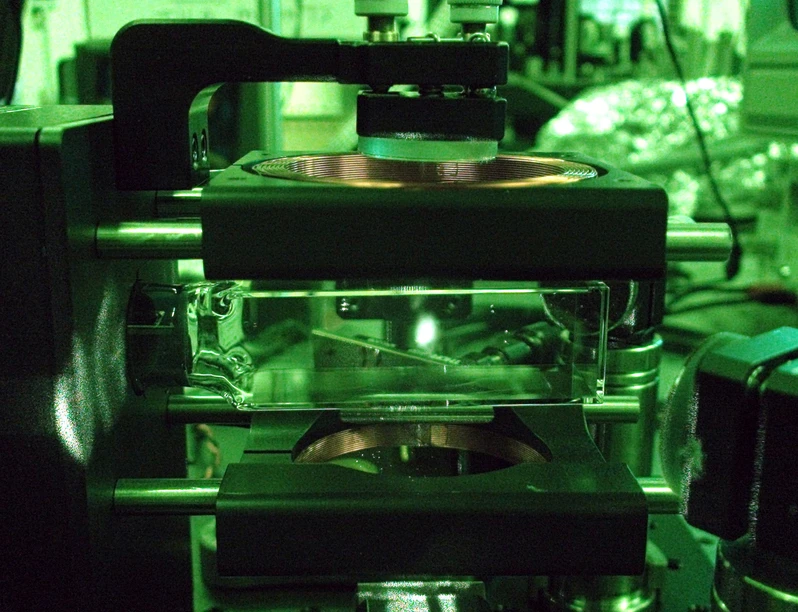
miniMOT Package
miniMOT Package
Introducing the miniMOT package, the ultimate solution for producing a compact and efficient magneto-optical trap (MOT). Our pre-assembled unit is easy to use and produces a live MOT within a few hours, saving both time and cost for even the most seasoned researchers. The package includes a 15”x18” aluminum breadboard with a periscope/beam-splitting/polarization assembly, mirrors for easy trap alignment, and a small B&W CCD camera for MOT imaging. The miniMOT package is not only ideal for teaching laboratories to introduce students to lasers, optics, and quantum matter, but also for quantum information experiments.
Features
miniMOT V2 and optics package to enable the production of a MOT
Pre-aligned for rapid deployment
Compact footprint for any laboratory benchtop
Ask our Applications team to learn more about suitable laser options for your system
Related Products
miniMOT V2
Introducing the miniMOT V2, a unique and compact off-the-shelf trapped atom vacuum system that enables users to effortlessly create and control quantum matter based on rubidium (Rb) or cesium (Cs) atoms.
With an intuitive user interface, the miniMOT V2 provides greater control over critical system parameters, increasing flexibility for cold atom experiments.
RuBECi
The RuBECi is a self-contained, tabletop, ultrahigh vacuum system for creating and manipulating ultra-cold atoms. It utilizes a two-cell vacuum system (a 2D+ MOT source cell and an ultra-high vacuum science cell compatible with long trap lifetimes). It features an atom chip for simple and rapid BEC production with a high-duty cycle and low power consumption.
Related Research
-
Achieving a Stable Magneto-Optical Trap
The utilization of the Magneto-Optical Trap (MOT) as a method for cooling and confining atoms is a recent development in the field of modern optical physics. Producing an effective MOT relies on a constant magnetic field throughout the trapping region and successful laser cooling, a technique used to achieve optical molasses by slowing particles using a three-dimensional intersection of laser beams. A successful MOT occurs when the trapped atoms slow down to approximately 30 cm/s at a temperature in the microkelvin range and is observable when a small bright orb of atoms is located in the center of the chamber. In this endeavor, the experimental setup for achieving a stable MOT was established using an array of infrared lasers provided by MogLabs. Future work on this project should seek to capture an image of trapped rubidium atoms using the ColdQuanta MiniMOT using the kit’s black and white CCD camera. Successfully establishing this MOT allows further testing to optimize its effectiveness and can be applied in future experiments to achieve Bose-Einstein Condensation.
Himeda, Chasen S., "Achieving a Stable Magneto-Optical Trap" (2018). Honors Thesis. 220.
-
Off-the-shelf Atom Trapping
We present results from a new commercial system available for cooling and trapping rubidium atoms in a Magneto-Optical Trap (MOT). The compact miniMOT system offered by Cold Quanta, Inc. consists of an ion pump, evacuated pyrex cell, and a rubidium source. The MOT system eliminates the need for ultra-high vacuum apparatus and expertise making it appropriate for undergraduate teaching and research labs. Our MOT has been implemented and maintained by student researchers. Using standard optical components, we have utilized three common trap geometries with this system: a standard spherical 6-beam MOT, a spherical mirror-MOT, and an anisotropic mirror-MOT. We present results of trap characterization and cold-atom spectroscopy in these configurations and discuss possible undergraduate teaching lab activities.
Himeda, Chasen S. "Achieving a Stable Magneto-Optical Trap." (2018).
-
Photonic integrated beam delivery in a rubidium 3D magneto-optical trap
Cold atoms are central to precision atomic applications including timekeeping and sensing. The 3D magneto-optical trap (3D-MOT), used to produce a cloud of cold atoms, will benefit from photonic waveguide integration to improve reliability and reduce size, weight, and cost. These traps require the delivery of multiple, large-area, collimated laser beams to an atomic vacuum cell. Yet, beam delivery using an integrated waveguide approach has remained elusive to date. We report demonstration of an 87Rb 3D-MOT using a fiber-coupled photonic integrated circuit to deliver all necessary beams to cool and trap more than 5 x 10^6 atoms to near 200 {\mu}K in a trapping volume that is an order of magnitude smaller than that of an equivalent atom number diffraction grating MOT. The silicon nitride photonic circuit transforms fiber-coupled 780 nm cooling and repump light via waveguides to three orthogonal non-diverging 2.5 mm x 3.5 mm free-space cooling and repump beams directly interface to the rubidium cell.







